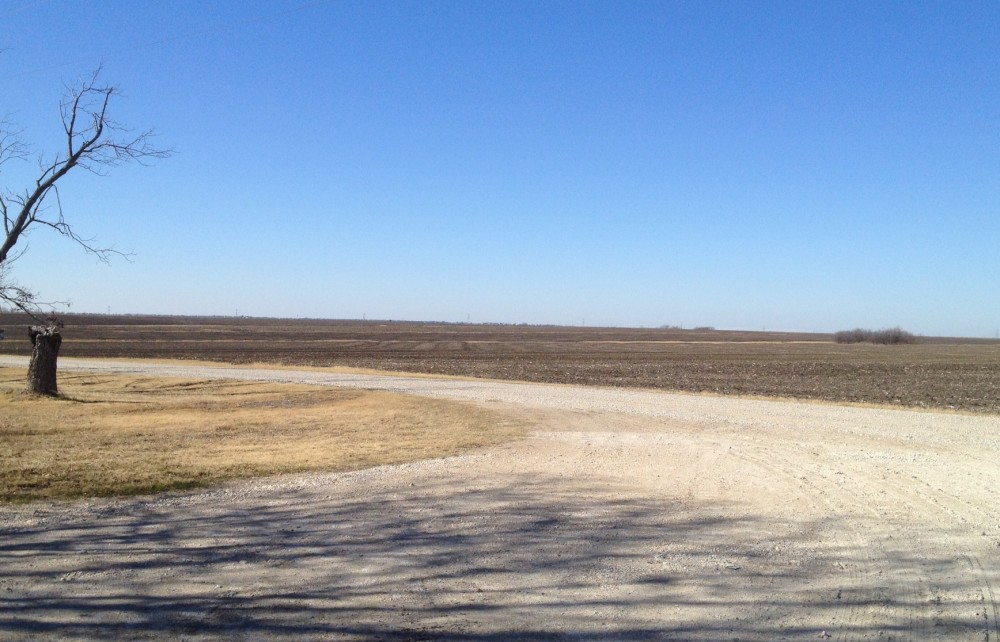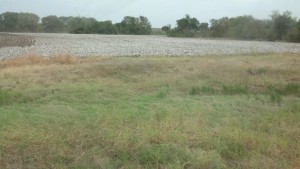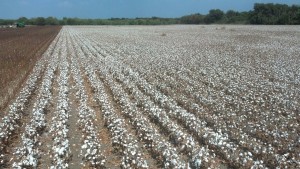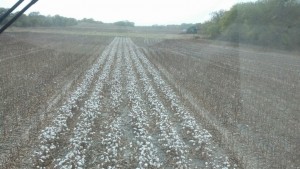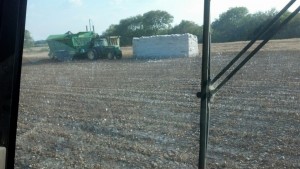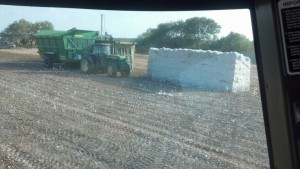It’s cotton harvest time in Texas.
Cotton is a soft fluffy fiber that grows in a boll (protective capsule) around the cotton seeds. The small shrub-like cotton plant is native to warm regions around the globe, and the lambs-wool plant was independently domesticated at different locations on separate continents in different ages. Cotton fabrics appear to have existed in Egypt over 10,000 years ago. Through the rest of the world, pieces of worn cotton shirts and socks have been discovered in Mexico (3,500 BC), India (3,000 BC), Peru (2,500 BC) and in the southwestern United States (500 BC). It may be fair to say that spun and woven cellulose fibers from the cotton plant have clothed our ancestors since the beginning of time, apparently viewed by them as an attractive and washable alternative to fig leaves and other natural coverings.
The English name “cotton” derives from the Arabic “qutn,” and the term “cotton” apparently entered into common use about 1400 AD.
Back to today and the Texas cotton harvest.
Uncle Joe first uses a chemical defoliant to allow the leaves of the cotton plant to dry and drop, leaving the bolls which have already burst open revealing the soft cotton. Here you see the defoliated fields of cotton waiting to be harvested:
Driving a cotton stripper, Uncle Joe removes the bolls from the stalks. Here is a picture from inside the cotton stripper. To the sides are the rows that have been stripped. Ahead are the rows about to be stripped.
Next the cotton is transferred to a module builder. In the builder, the newly harvested cotton is compacted into huge bricks (modules). You may be looking at the first cotton module of the season.
The modules are picked up on flat-bed trailers and transported to the cotton gin. Hand-operated gins have been around forever, but the first modern mechanical gin was invented by Eli Whitney in 1793.The cotton gin separates the fibers from the seeds, so the fibers can be processed into clothing and other cotton products, like diapers and $100 bills (Yep, U.S. paper currency is composed of 75% cotton).
Aunt Martha operates the local cotton gin and has for over 50 years. She takes those cotton-boll modules, and using Eli’s new machining techniques, brushes out the seeds (which can be replanted or made into oils and feeds). Then she bales the soft cotton fibers for sale around the world.
The United States is the leading exporter of cotton in the world, and Texas is the #1 cotton-producing state. Texas is responsible for about 25% of the U.S. cotton crop, and the Lone Star State has over 6 million acres (9,000 square miles) of cotton fields stretching across its length.
Louisiana is another close-by, cotton-growing state. Both states have their share of cotton, as musically noted by Johnny Cash and Credence Clearwater Revival in their renditions of the song, “Cotton Fields Back Home”:
When I was a little bitty baby
My mama would rock me in the cradle,
In them old cotton fields back home;
It was down in Louisiana,
Just about a mile from Texarkana,
In them old cotton fields back home.
Cotton is an old friend in the U.S., ranking #5 on the list of major agricultural crops: 1) corn, 2) soybeans, 3) hay, 4) wheat, 5) cotton, 6) sorghum (milo), and 7) rice.
When it comes to cotton, the United States is in good company. Across our planet, the top 10 cotton-producing countries are: 1) China, 2) India, 3) United States, 4) Pakistan, 5) Brazil, 6) Uzbekistan, 7) Turkey, 8) Australia, 9) Turkmenistan, and 10) Argentina. The top exporters are: 1) United States, 2) India, 3) Brazil, 4) Australia, and 5) Uzbekistan. And the top nonproducing importing countries are Korea, Taiwan, Russia and Japan. Everyone loves cotton.
Although cotton is with us just about everywhere, it is not the biggest crop in the world. By quantity harvested worldwide, the leaders are: 1) sugar cane, 2) corn, 3) rice, and 4) wheat. Cotton is way down the lists. Cotton is not even in the top 20 by quantity and is only number 16 by value of the harvest.
Cotton may not be the biggest crop in the world, but cotton is certainly the most felt, the closest to us on our daily travels, and a comfort when we close our eyes at night.
I don’t know about you, but my shirt’s on to cotton.
Grandpa Jim
